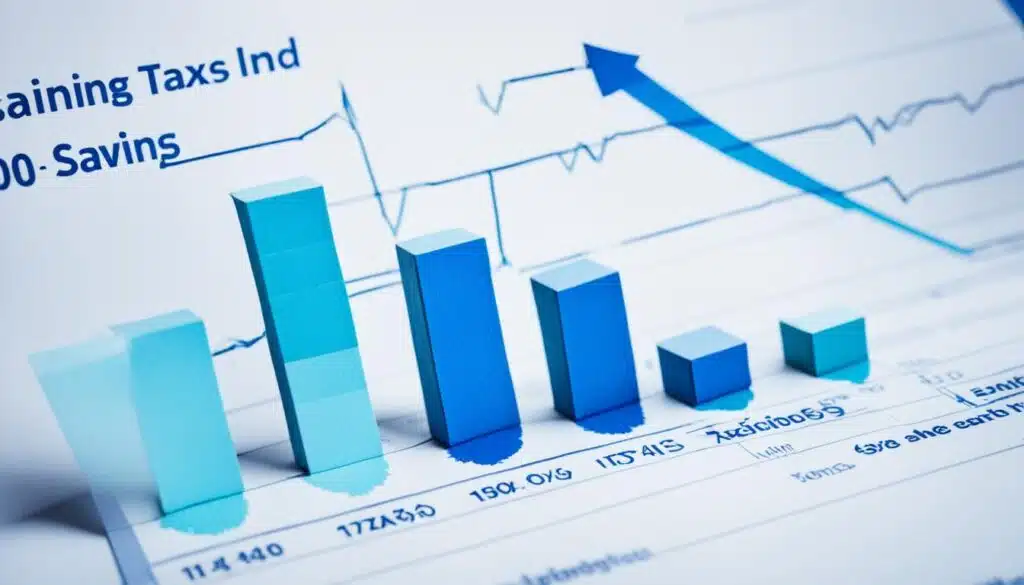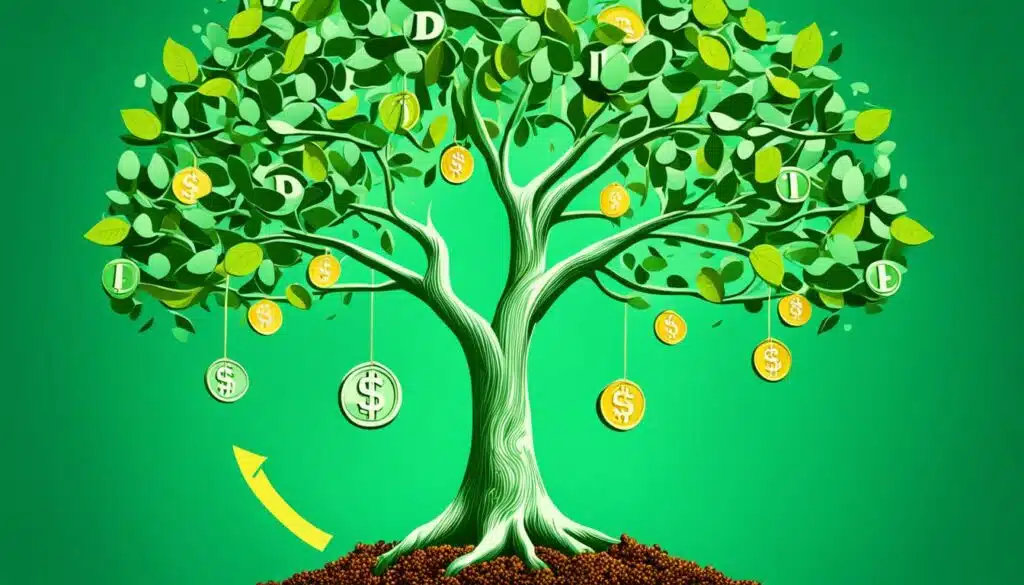Save Money On Taxes take a lot of your money. But, with the right tricks, you can keep more cash legally. This article looks at ten ways to cut your tax bill in the UK.
Key Takeaways
- Utilise your personal tax allowance to reduce your taxable income
- Claim the marriage tax allowance if you’re married or in a civil partnership
- Make the most of your personal savings allowance to earn tax-free interest
- Maximise your ISA allowance to invest in a tax-efficient manner
- Claim your dividend allowance to receive up to £1,000 in dividends tax-free
Utilise Your Personal Tax Allowance
If you live in the United Kingdom, you have a great way to save on taxes: the personal tax allowance. Right now, this stands at £12,570. It lets you earn a set amount of money each year without paying tax. By using your personal tax allowance wisely, you could save a lot by keeping some of your income tax-free.
This rule covers various types of money you might make. It’s not just your regular salary. Things like pensions, rental incomes, and even money from abroad count, too. As long as all these add up to no more than £12,570, you won’t have to pay tax on them.
Tax-Free Income Opportunities
- Money from your pension: This is tax-free if it’s within your personal allowance.
- Earnings from rentals: Money made from your property can also count towards this tax-free amount.
- Offshore bond profits: Even money from investing in bonds abroad can be tax-free up to your allowance.
Thoughtfully arranging your finances can cut down your tax bill. This way, more of what you earn stays with you.
| Income Type | Tax-Free Allowance |
|---|---|
| Pension Income | £12,570 |
| Rental Income | £12,570 |
| Offshore Bond Income | £12,570 |
Using your personal tax allowance well is a smart move to save money on taxes. It helps you keep more of what you earn.
Also Read : Best Ways To Save Money On A Wedding?
Claim the Marriage Tax Allowance
Married or in a civil partnership? You might save up to £251 yearly with the marriage tax allowance. This tax break lets you share part of your personal tax-free amount with your partner. By doing this, you reduce their tax bill and save more money at home.
The Marriage Tax Allowance Explained
The marriage tax allowance lets one partner transfer up to 10% of their tax-free amount to the other. If your partner earns less and pays the basic rate of tax, this is a big benefit. It means you could cut your joint tax bill significantly, saving money every year.
You need to fit a few criteria to claim this allowance:
- You’re married or in a civil partnership
- Your partner earns less than you do
- They pay the basic tax rate
- You can transfer some of your unused tax-free amount
By making use of this tax allowance, you both could save £251 annually. It’s a great help for married or civil partners wanting to improve their tax situation and save more at home.
| Tax Year | Maximum Potential Saving |
|---|---|
| 2023/24 | £251 |
| 2022/23 | £252 |
| 2021/22 | £250 |
“The marriage tax allowance is a simple yet effective way for married couples and civil partners to reduce their tax bill and boost their overall household savings.”
This allowance helps you save on tax, which you can then spend on family goals or daily needs. It’s a smart, but often missed, way for UK married and civil partners to save money.
Also Read : Best Ways To Invest Money For Beginners?
Make the Most of Your Personal Savings Allowance

When you want to save money on taxes, the personal savings allowance is key. In the United Kingdom, it lets most people earn savings interest tax-free each year.
Your allowance depends on your tax rate. So, non-taxpayers and basic rate taxpayers can get up to £1,000 tax-free. Higher rate taxpayers can get up to £500 tax-free. For those saving a lot, this is a big help. It means less tax on the interest they earn.
To use your personal savings allowance, watch your interest income. Make sure it doesn’t go over your allowance. Not sure how much you can earn tax-free? Talk to a financial advisor. Or use an online tool to figure it out.
Making the most of your tax-free savings interest can save you money. You won’t be paying as much tax. It’s an easy way to manage your savings better and boost your financial health.
“The personal savings allowance is a valuable tool for anyone looking to maximise their savings and minimise their tax burden.”
Utilise the Savings Rate Band

For those earning under £17,570 a year, there’s a neat trick. They can get up to £5,000 in savings interest tax-free. This special rule helps out people with lower incomes.
The savings rate band is a great option for people with savings but not a lot of yearly income. They use this chance to grow their savings without worrying about taxes.
Let’s look at an example to understand this better. A retired person gets £12,000 yearly from their pension. They have £50,000 in savings. If they earn £1,000 interest at 2%, they’d usually pay tax on it. But with the savings rate band, they get the first £5,000 interest tax-free.
| Income Level | Savings Rate Band Allowance |
|---|---|
| Less than £17,570 | Up to £5,000 in tax-free savings interest |
Importantly, the savings rate band adds to the personal savings allowance. This means non-taxpayers and those in the basic tax rate can get up to £1,000 in savings interest tax-free. Higher-rate taxpayers can get up to £500 tax-free. With these two, people with lower incomes can save a lot on their taxes.
“The savings rate band is a little-known but powerful tool that can help lower-income earners maximise their tax-free savings.”
Also Read :Best Money Saving Challenges For Financial Success
Maximise Your ISA Allowance

In the United Kingdom, everyone gets the chance to use a special savings way, the ISA. You can save up to £20,000 every year in an ISA. This helps you grow your money without worrying much about taxes.
When you put your money in an ISA for stocks and shares, you avoid some big taxes. No tax on dividends or what you earn makes your money grow faster. Plus, you don’t pay capital gains tax when you sell.
Explore the Benefits of ISAs
- Invest up to £20,000 per tax year without paying any personal income tax or capital gains tax on your investment returns.
- Choose from a variety of ISA types, including Cash ISAs, Stocks and Shares ISAs, and Innovative Finance ISAs, to suit your investment goals and risk appetite.
- Easily transfer your existing ISA savings to a new provider, allowing you to optimise your investment strategy as your needs evolve.
Make the most of your ISA allowance. Invest in ways that help you reach your money goals and avoid tax on your tax-free investments.
“The power of tax-free compound growth within an ISA can be truly transformative for your long-term wealth.”
| ISA Type | Key Features | Contribution Limit |
|---|---|---|
| Cash ISA | Earn interest on your savings tax-free | £20,000 per year |
| Stocks and Shares ISA | Invest in a wide range of assets, including stocks, shares, and funds, without paying tax on your returns | £20,000 per year |
| Innovative Finance ISA | Invest in peer-to-peer lending and crowdfunding platforms, earning tax-free returns | £20,000 per year |
Claim Your Dividend Allowance

The dividend allowance is a big tax saver for UK residents. It lets you earn up to £1,000 in dividends without any tax. This is very useful for people with shares or for company directors getting dividends.
By using this allowance, you can make some of your dividend income tax-free. It helps lower your tax bill a lot each year. So, it’s a good strategy to save on taxes.
Tax-Free Dividends
The UK’s tax system includes the dividend allowance to ease the tax load. It’s different from the personal savings allowance, which deals with savings interest. The dividend allowance focuses only on dividend income.
If you get dividends from investments or as a company director, you can use the dividend allowance. It lets you enjoy your dividends without any tax. You can get it for all your dividend income, no matter its source.
- The dividend allowance for the 2023/24 tax year is £1,000.
- Any dividends received within this allowance will be completely tax-free.
- The allowance applies to dividend income from both UK and overseas companies.
Making smart use of the dividend allowance cuts down your tax on investment income. This means more money in your pocket. It’s a great move for your finances and to lessen your tax load.
“The dividend allowance provides a straightforward way to minimise the tax you pay on your investment income.”
| Tax Rate | Dividend Allowance | Tax-Free Dividends |
|---|---|---|
| Basic Rate (20%) | £1,000 | £1,000 |
| Higher Rate (40%) | £1,000 | £1,000 |
| Additional Rate (45%) | £1,000 | £1,000 |
Save Money On Taxes

Using smart tax planning strategies can lower the amount you pay in taxes. By knowing about allowances, deductions, and tax-efficient investments, you can save more money. It’s best to look into these options throughout the year, not just at the tax deadline. This way, you can make your money go further and build wealth better.
Maximising your personal allowances is a top way to save on taxes. This means utilising your personal tax allowance and other exemptions. For instance, if you’re married, you can also use the marriage tax allowance to your benefit. Doing so, you will lower your tax bill and keep more in your pocket.
Investing in tax-friendly options like ISAs is another wise move. With an ISA, you don’t pay taxes on the money you earn or the money you gain when you withdraw. Over time, these benefits can add up to substantial tax savings.
Your pension can also be a great source of tax savings. Make use of allowances like pension annual and carry forward to put more money away for the future. Doing this cuts your taxable income and boosts your tax savings long term.
Always keep an eye on tax changes and work with a financial advisor. They can help tailor a tax savings plan to your specific needs. This kind of support ensures your financial plans align with the best tax strategies, saving you money.
“Effective tax planning is the key to unlocking significant tax savings and building long-term wealth.”
To wrap up, using these tax planning strategies early can have big benefits. The earlier you start to plan, the more money you can save and the better you can secure your financial future.
Also Read : How To Make Money With Real Estate?
Take Advantage of the Pension Annual Allowance

The pension annual allowance is vital if you’re saving for when you stop working. It lets you put up to £60,000 a year into your pension. You then get tax relief on this money you put in.
If you pay tax at the basic rate, the government gives you £25 extra for every £100 you save. If you pay tax at the higher rate, they add £45.
What’s more, any money in your pension grows without being taxed. This makes pensions a smart way to build your retirement fund. Using the pension annual allowance fully can really increase your savings. This, in turn, means you could live a richer life when you retire.
- Contribute up to £60,000 per year into a pension
- Receive pension tax relief on your contributions, ranging from 20% to 45% depending on your tax rate
- Enjoy tax-free growth of your pension funds, free from income and capital gains taxes
“Pensions are one of the most tax-efficient ways to save for retirement. By maximising your pension annual allowance, you can significantly enhance your long-term financial security.”
It’s wise to regularly check your pension contributions. If you can, think about putting in more. Saving more means you get extra help through tax breaks. Plus, your pension can grow bigger over time.
Also Read :How To Make Money From Home?
Utilise the Pension Carry Forward Allowance

Besides the regular pension allowance, there’s the pension carry forward allowance. You can carry forward any unused allowance from the past three tax years. This might let you put in up to £180,000 in one year. It’s great for people who can add more to their pension.
The carry forward works with part of your £40,000 yearly pension allowance. If you didn’t use it all in the last three years, that’s okay. You can catch up now by contributing more in this tax year.
- For example, if you only put £20,000 in your pension each year for the past three years, you could have £60,000 left over.
- Now, you can add up to £100,000 (£40,000 from this year plus the £60,000 carry forward).
- This method is excellent for those with money to spare. It helps maximise tax relief and grow your pension.
“The carry forward allowance can be a valuable strategy for those who have the financial capacity to make larger pension contributions.”
For this allowance, make sure you have enough money. You must also know the rules. It’s wise to get advice to use this and your tax plans wisely.
| Tax Year | Pension Allowance | Unused Allowance |
|---|---|---|
| 2019/20 | £40,000 | £20,000 |
| 2020/21 | £40,000 | £20,000 |
| 2021/22 | £40,000 | £20,000 |
| 2022/23 | £40,000 | £0 |
| Total Carry Forward | – | £60,000 |
Also Read: What Are The Key Features Of An Effective Money Dashboard?
Conclusion
Handling your taxes well can boost your finances. It helps you cut down tax payments and keep more money. This could mean having extra cash to save or invest.
Remember, tax planning is a steady effort. It’s smart to check your finances often. This way, you won’t miss any chances to save tax. Many routes, like using your full personal allowance or claiming a marriage tax break, are open for you to explore.
Good tax planning is more than just about tax cuts. It’s about linking your money moves with your dreams. By being alert and taking early steps, your financial future can be brighter. Make use of various allowances and deductions to make the most of your wealth.
FAQs
How can I utilise my personal tax allowance to save money on taxes?
In the UK, you have a ‘Personal Allowance’ of £12,570. Anything you earn below this amount is tax-free, like pension or rental income. This also includes money from offshore bonds.
How can the marriage tax allowance help me save money on taxes?
If you’re married or in a civil partnership, you can share tax benefits. You can give up to 10% of your personal allowance to your partner. This might save you both up to £251 a year.
What is the personal savings allowance and how can it help me save on taxes?
Most people can earn some interest on savings without paying tax. How much you can earn tax-free is linked to your tax band. For example, basic rate taxpayers can earn up to £1,000 a year tax-free on savings.
How can I utilise the savings rate band to save on taxes?
If you earn less than £17,570 a year, you might not need to pay tax on some savings interest. This applies to the first £5,000 of savings interest for those eligible.
How can I maximise my ISA allowance to save on taxes?
Everyone gets a £20,000 ISA allowance each year. Investing in stocks and shares ISAs can avoid some taxes. This includes protecting against taxes on dividends and profits from sales.
What is the dividend allowance and how can it help me save on taxes?
You can earn up to £1,000 a year from dividends tax-free. This benefit is useful if you own shares or work as a company director through stocks not held in an ISA.
How can I take advantage of the pension annual allowance to save on taxes?
Each year, you can add up to £60,000 to your pension with tax relief. This money then grows without being taxed for income or capital gains. It’s a way to save on future taxes.
What is the pension carry forward allowance and how can it help me save on taxes?
Along with your usual pension annual allowance, you can add up unused allowances from the past three years. This might let you put as much as £180,000 into your pension, saving on taxes.









